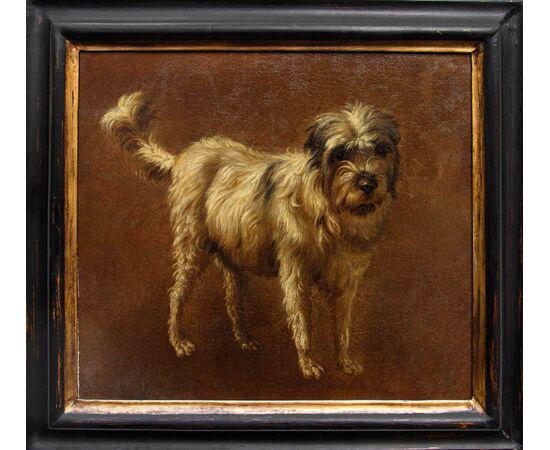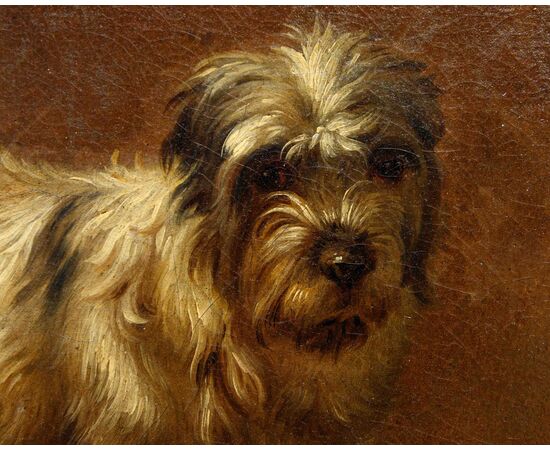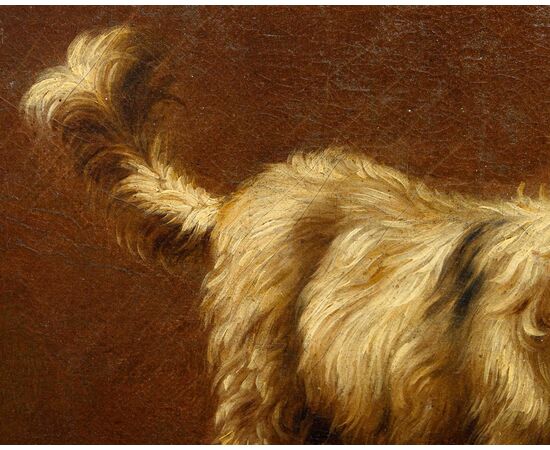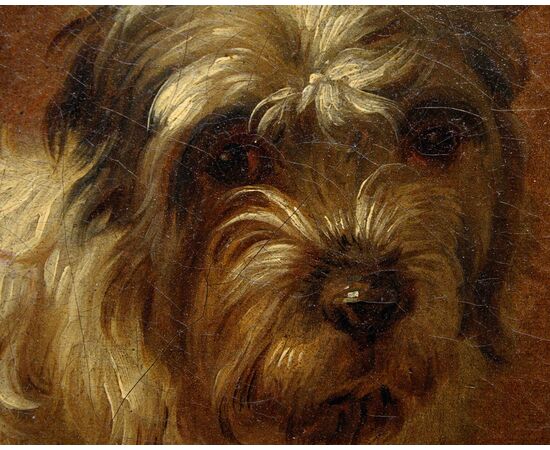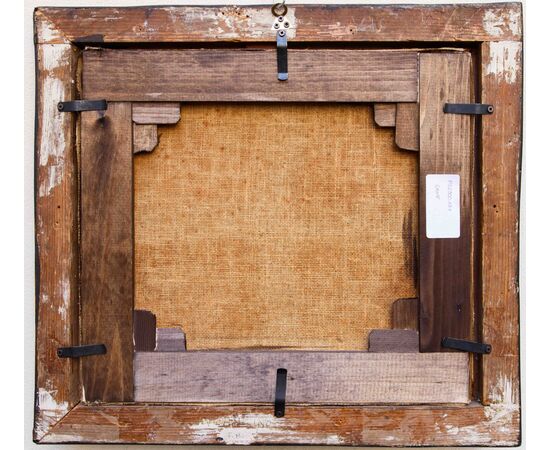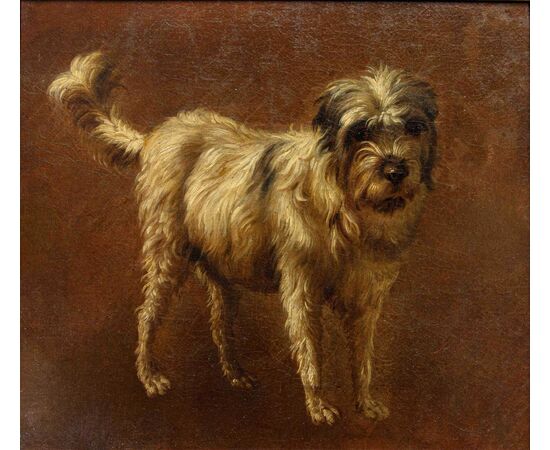Francesco Londonio (Milan, 1723 – 1783), Portrait of a small dog
Francesco Londonio (Milan, 1723 – 1783)
Portrait of a small dog
Oil on canvas, 30 x 40 cm
With frame, 45 x 49 cm
Francesco Londonio, born in Milan in 1723, was a prominent figure in the Lombard artistic scene of the 18th century, distinguishing himself for his mastery in representing pastoral scenes, landscapes, and, above all, animals. His art, which blended naturalistic observation with a Rococo taste and a pre-Romantic sensibility, offers a fascinating glimpse into rural life and the culture of his time. Londonio had a varied and cosmopolitan artistic education. Although sources do not always agree on the details regarding the early period of his artistic activity (he most likely frequented the workshop of the painter Ferdinando Porta in Milan), it is known that in his youth he spent a period in Rome, where he had the opportunity to study the great masters of landscape and deepen his knowledge of classical art: this experience was fundamental for the development of his style, enriching it with compositional and perspective elements. During his training years, he also stayed in Parma, where Correggio's works deeply impressed him and irreversibly shaped his visual imagery. In his youth, the artist also studied engraving alongside the acclaimed Lombard master Benigno Bossi, achieving valid results also with regard to this art form. Londonio's first certain work is identifiable with a drawing from life, A Bull and a Cow Resting, dated 1753 and kept in the Biblioteca Ambrosiana in Milan. His first signed painting, Cattle Market, dates back to 1756 and is currently in a private Milanese collection. Londonio focused mainly on painting animals and rural scenes, often depicting shepherds and livestock. What mostly distinguishes the Milanese painter's production is his extraordinary ability to portray animals. Goats, sheep, cows, donkeys, but also dogs and birds, come to life on his canvases with surprising verisimilitude and liveliness. His style is characterized by a refined approach to pastoral subjects, which undoubtedly draws inspiration from the art of Giovan Battista Castiglione, known as il Grechetto, and the Flemish masters active between the seventeenth and eighteenth centuries in Italy, including Philipp Peter Roos, mainly known as Rosa da Tivoli. Londonio did not limit himself to mere reproduction, but managed to capture the essence and character of each species, often inserting them into rural contexts that enhanced their presence. His pastoral scenes, often animated by shepherds, farmers and wayfarers, reflect an idealized Arcadia, but always anchored to a profound observation of Lombard nature. Many of his engravings reproduce studies of animals or genre scenes, demonstrating his continuous research and his attention to detail. Although he was particularly known for his animal painting, Londonio also produced some still lifes and various portraits of the most prominent figures of Lombardy of his time. His work obtained recognition and he was even appointed art designer for the newly founded Teatro alla Scala in Milan by Empress Maria Theresa of Austria, probably thanks to his work on the nativity scene in the Church of San Marco. Londonio died in Milan on December 26, 1783 and was buried in his parish of S. Eufemia. A series of his etchings with studies of animals was published posthumously by Prince Alberico Barbiano di Belgioioso d'Este, guaranteeing its extraordinary critical and visual fortune in a period shortly after his death. Although he did not have a formal school, he had numerous imitators and followers, which sometimes leads to confusion in the attribution of works. Londonio left a significant artistic legacy in Milan. His works are now kept in important museums and private collections, particularly in Lombardy, where they remain a precious testimony of the taste and culture of the eighteenth century.
This painting, which, due to its iconographic and stylistic characteristics, fits well into Francesco Londonio's production, depicts a dog with long and shaggy fur, in light tones, with darker, almost black streaks, creating a variegated effect, especially on the head and back. The dog is depicted in full figure, in an upright and slightly frontal pose, with its gaze directed towards the viewer, suggesting an attentive and lively expression. Its tail is high and bushy, curled on its back. The fur is rendered with great attention to detail, highlighting its voluminous and ruffled texture, typical of a terrier breed or a mixed breed with those characteristics. The background is of a uniform and dark color, a deep brown that highlights the light figure of the dog. This type of neutral background is common in Londonio's works, as it allows attention to be focused on the animal, which is the true protagonist of the scene.
The lighting comes from the left, creating soft shadows and highlighting the three-dimensionality of the dog, the protagonist of the painting. The brushstroke, while detailed in the rendering of the fur, maintains a certain freedom, typical of the eighteenth century, and of Londonio's manner, which preferred a naturalistic but not slavish rendering of animals. The work, with its attention to zoological detail and the simple but effective composition, aligns perfectly with the style and themes favored by Francesco Londonio, famous for his ability to capture the essence and vitality of animals.

